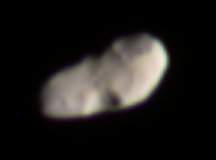
| |||||||
| Discovery | |||||||
|---|---|---|---|---|---|---|---|
| Discovered by | Pascu, Seidelmann, Baum and Currie | ||||||
| Discovered in | March 13, 1980 | ||||||
| Orbital characteristics | |||||||
| Semimajor axis | 294,619 km | ||||||
| Eccentricity | 0.000 | ||||||
| Orbital period | 1.887802 d [1] | ||||||
| Inclination | 1.56° (to Saturn's equator) | ||||||
| Is a satellite of | Saturn | ||||||
| Physical characteristics | |||||||
| Mean diameter | 19 km (either 30x16x16 or 34x22x22) | ||||||
| Mass | ? kg | ||||||
| Mean density | ? g/cm3 | ||||||
| Surface gravity | ? m/s2 | ||||||
| Rotation period | synchronous | ||||||
| Axial tilt | zero | ||||||
| Albedo | ? | ||||||
| Surface temperature |
| ||||||
| Atmosphere | none | ||||||
- This article is not to be confused with asteroid 53 Kalypso.
Calypso (kə-lip'-soe, IPA /kəˈlɪpso/, Greek Καλυψώ) is a moon of Saturn. It was discovered by Pascu, Seidelmann, Baum and Currie in 1980 from ground-based observations, and was designated 1980 S 25. In 1983 it was officially named after Calypso of Greek mythology. It is also designated as Saturn XIV.
Calypso is co-orbital with the moon Tethys, and resides in Tethys' trailing Lagrangian point (L5) 60 degrees behind Tethys. The moon Telesto resides in Tethys' leading Lagrangian point, 60 degrees ahead of Tethys.
Like many other small Saturnian moons and small asteroids it is irregularly shaped by overlapping large craters and appears to also have loose surface material capable of smoothing the appearance of craters.
| This article is a stub, and may need more information. You can help Space Wiki by expanding it. |
|---|
External links[]
| edit Saturn's natural satellites |
|---|
| Pan | Daphnis | Atlas | Prometheus | S/2004 S 6 | S/2004 S 4 | S/2004 S 3 | Pandora | Epimetheus and Janus |
| Mimas | Methone | Pallene | Enceladus | Telesto, Tethys, and Calypso | Polydeuces, Dione, and Helene | Rhea |
| Titan | Hyperion | Iapetus | Kiviuq | Ijiraq | Phoebe | Paaliaq | Skathi | Albiorix | S/2004 S 11 | Erriapo | Siarnaq |
| S/2004 S 13 | Tarvos | Mundilfari | S/2004 S 17 | Narvi | S/2004 S 15 | S/2004 S 10 | Suttungr | S/2004 S 12 |
| S/2004 S 18 | S/2004 S 9 | S/2004 S 14 | S/2004 S 7 | Thrymr | S/2004 S 16 | Ymir | S/2004 S 8 |
| See also: Pronunciation key | Rings of Saturn | Cassini-Huygens | Themis |